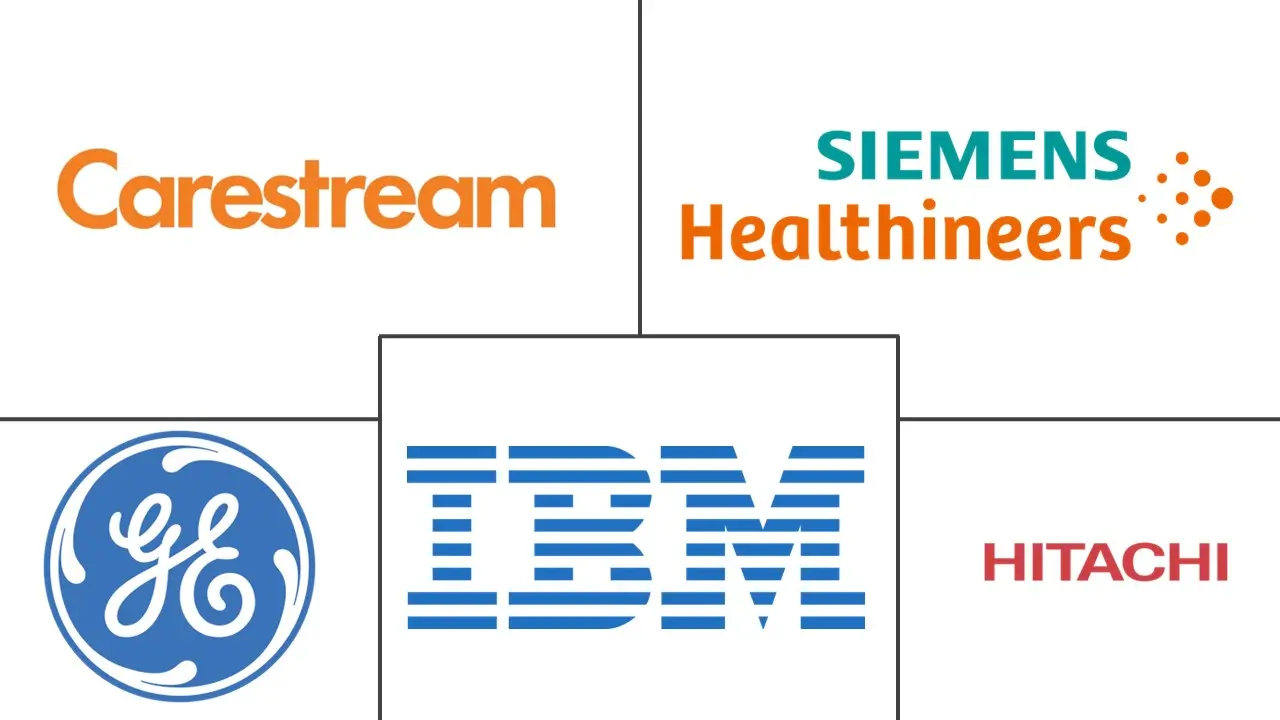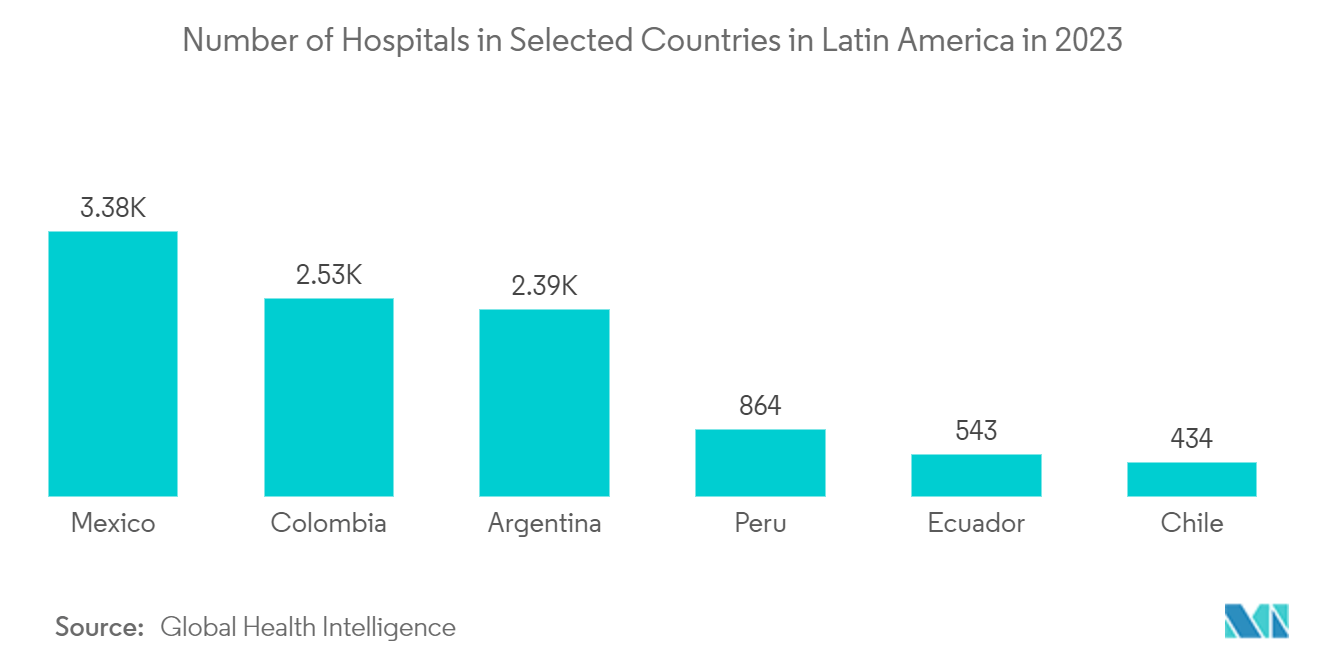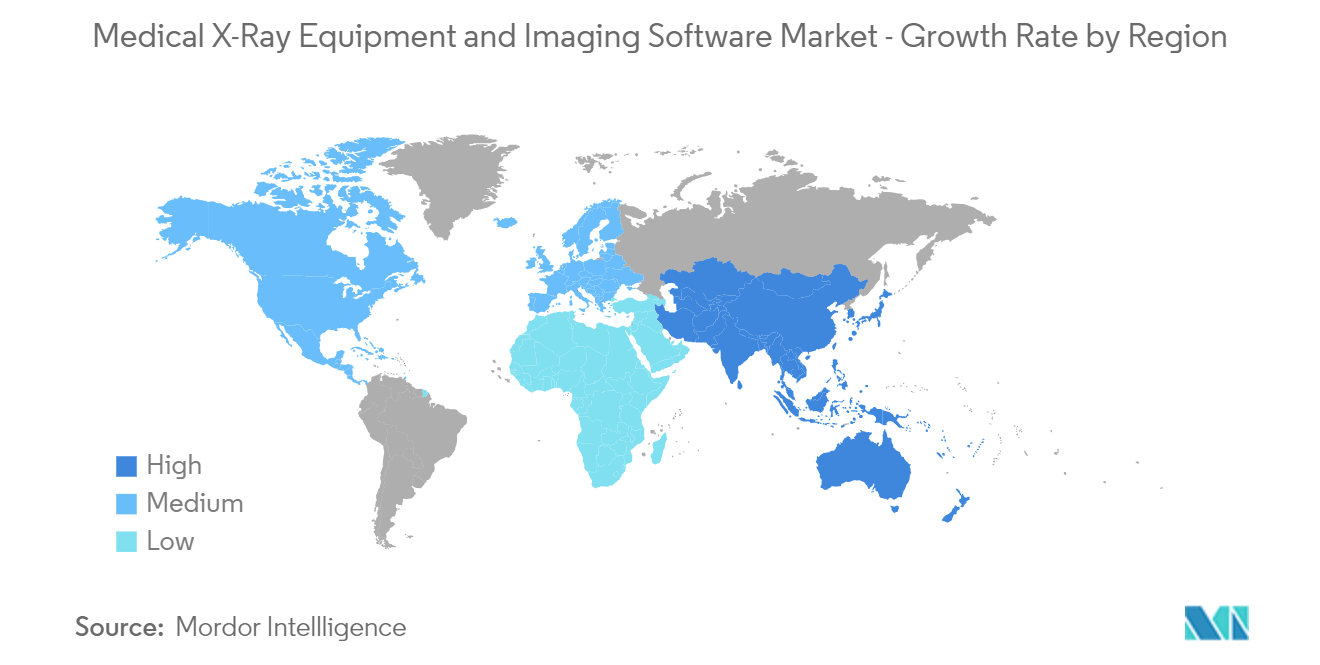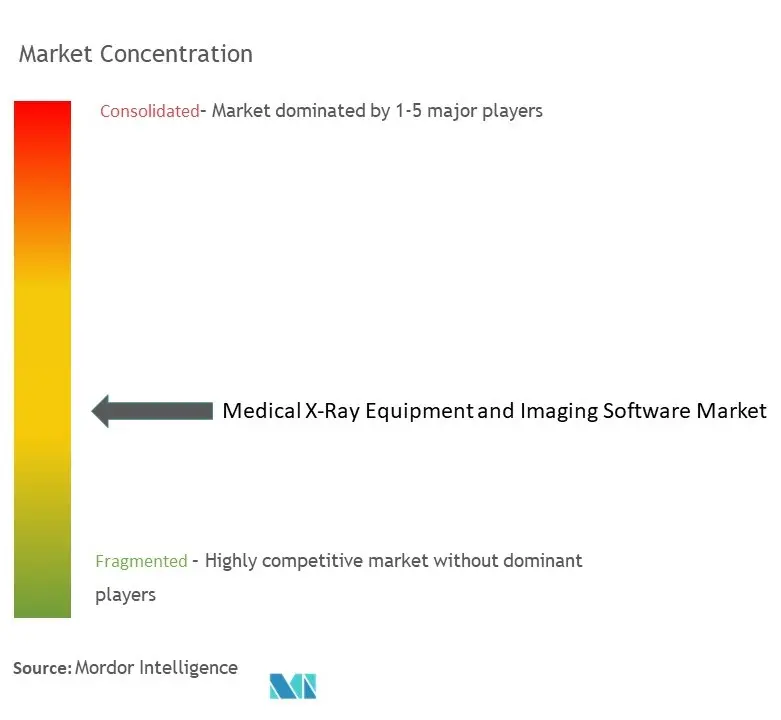Medical X-Ray Equipment and Imaging Software Market Analysis
The Medical X-Ray Equipment And Imaging Software Market size is estimated at USD 3.66 billion in 2025, and is expected to reach USD 4.58 billion by 2030, at a CAGR of 4.6% during the forecast period (2025-2030).
The medical X-ray equipment and imaging software market was valued at USD 3.20 billion last year and is expected to reach USD 4.32 billion by the end of the forecast period by registering a CAGR of 4.60 percent during the forecast period. Over the projected period, it is anticipated that an older population on the rise and increasing investments in the healthcare environment will favorably boost market growth overall. Developed countries have been investing in providing these individuals with accessible healthcare systems, which has boosted the market.
- One of the fundamental healthcare systems used in many hospitals and other medical facilities is X-ray equipment and imaging software. X-ray imaging is widely used in medical settings because it enables painless and non-invasive diagnosis and therapy monitoring.
- The variety of uses for X-rays, including those for bone fractures, infections (including pneumonia), calcifications, tumors, arthritis, dental, heart, blood vessel blockages, digestive, cysts, cancer, asthma, lung diseases, etc., demonstrates the wide range of diagnostic and therapeutic uses for x-rays that have sustained market demand.
- Moreover, dental applications in the medical field necessitate quicker and more compact scans. According to Listerine Professional, oral disorders afflict 3.9 billion individuals worldwide, making them the most common health problems. Consequently, it is anticipated that the primary need for X-ray imaging will rise in the dental sector in the following years.
- Additionally, since the healthcare sector has been increasingly digitalized, chip technology adoption has emerged as one of the critical drivers of the growth of the medical equipment market. This tendency has led to increased use of sensors and motion micro-electromechanical systems, microcontrollers, analog devices, memory power management devices, etc. In the X-ray equipment and imaging market, factors including rising usage of remote patient monitoring systems, advancements in diagnostic and treatment methodologies, and a high prevalence of non-communicable diseases are also anticipated to propel semiconductor growth.
- Despite this, Product makers are expected to stay one step ahead of the competition owing to technological improvements in imaging equipment, digital technology applications, automation, etc. Increased demand for 3D medical imaging devices also expands the market. Suppliers and governments are expected to boost their investments in cutting-edge imaging technology to assure security, dependability, and affordability.
- According to the UN data of World Population Prospects, the number of people above 65 years is steadily increasing. By 2050, the world's population aged 60 years and more is predicted to touch 2 billion, of which 80 percent may live in low- and middle-income countries. Hence, the growing geriatric population and the surging number of orthopedic and cardiovascular procedures may further drive the adoption of medical imaging in healthcare applications.
- The growth of the international market for medical X-ray imaging and equipment is expected to be hampered by high test costs for medical imaging and limited access to essential infrastructure. Furthermore, the lack of professionals with experience in the use of medical equipment continues to be a severe issue in developing nations.
Medical X-Ray Equipment and Imaging Software Market Trends
Diagnostic Centers Majorly Drive the Market Demand
- The medical X-ray equipment and imaging industry is witnessing a growth in the number of imaging and diagnostic tests performed per year owing to various factors, such as increasing focus on radiological diagnostic tests and rising chronic disease burden through mergers and consolidation in the medical devices market.
- Diagnostic centers offer thorough screening and diagnostics to give the best possible care and meet the patient's needs. More diagnostic facilities are opening up to accurately diagnose patients as the incidence of infectious and non-communicable diseases rises.
- A diagnostic radiograph's ability to be produced depends on several variables. One of those variables is the reproducibility of X-ray exposure to specific radiographic technique variables, like X-ray tube voltage and current. The "linear" response of the X-ray dose to changes in the X-ray tube current is another element that significantly impacts the quality of X-ray images. To create the radiographic image reliably, the relationship between tube current and X-ray production must be "linear."
- Moreover, many companies are investing in insulated gate bipolar transistors (IGBT), which are used to power CT scanners and X-ray machines, among other medical diagnostic devices. The IGBT-based power supply's superb management of the voltage given to the X-ray tube enhances the image quality. The Statistics Bureau of Japan estimates that by 2024, the revenue from X-ray equipment in Japan will be over 3.5 billion USD, up from 3.3 billion in 2022. Such advancements in the medical field may further fuel market expansion.
- Most countries spend highly on the healthcare industry and upgrade to the latest equipment and solutions in their diagnostic centers to improve health. However, a few countries, such as the United States, underperform in healthcare. For instance, the United States spends approximately 7 percent to 10 percent more than other similar countries; however, life expectancy is low. This creates a new avenue for companies to invest in advanced equipment and imaging software to improve the healthcare ecosystem.
- In addition, with healthcare costs in all of Europe rising quickly, the X-ray tube market in that region is predicted to expand much more rapidly than it did over the previous five years. President Vladimir Putin unveiled the national "Health Care" project, which seeks to extend Russians' life expectancy from 73 to 78 years and lower the mortality rate from cancer and cardiovascular disease by 2024. The expected annual investment in this project is 40 billion euros. The government intends to limit the export of medical equipment (diagnostic imaging: dental products, orthopedics, and other medical devices).
- Furthermore, a growing need for medical diagnostics across numerous regions may further contribute to market expansion. X-ray machines are also necessary due to the rise in cardiovascular disorders. For instance, According to a recent analysis by the Population Reference Bureau (PRB), by 2030, 81 percent of fatalities in Latin America will be attributable to the four main non-communicable diseases: cardiovascular disease, most malignancies, diabetes, and chronic respiratory disorders. Due to this, in August 2022, the International Finance Corporation funded USD 30 million to the pharmaceutical firm Laboratorios Siegfried to improve access to high-quality, reasonably priced healthcare for lower-income communities throughout Latin America and the Caribbean (LAC).
Asia-Pacific to Account for a Significant Share
- The Asia-Pacific region is expected to expand at a considerable rate during the forecast period. Significant factors supporting the growth are rising investments in research and innovation centers, government programs, and policies favoring the IT healthcare equipment and devices markets.
- Owing to the rising frequency of chronic diseases and the increased need for high-quality healthcare, Asia-Pacific is anticipated to develop faster than other areas. The market will also be significantly supported by the increasing PACS (Picture Archiving and Communication System) adoption in digital X-ray systems due to the benefits of greater image quality and faster processing.
- The APAC region is witnessing a surge in the geriatric population and an increase in chronic diseases due to sedentary lifestyles and unhealthy eating habits. Moreover, rising medical infrastructure developments with increased medical facilities are expected to propel the demand for medical X-ray equipment.
- The Chinese government has also been implementing a stream of supportive policies to improve the overall healthcare structure. The Health China 2030 plan is a comprehensive set of guidelines to extend the services to all by 2030 and focuses on public health. Such initiatives for improving healthcare standards are driving the growth of the Chinese X-ray tube market.
- Moreover, x-ray computed tomography (CT) imaging is increasingly used in structural engineering. Scanning a concrete specimen using X-ray tomography provides insights into the inner structure without destroying the specimen. Studying the internal design of cement-based materials is extremely important for understanding and modeling the transport phenomena that affect its durability.
- Additionally, To generate attractive revenue streams, APAC firms in the global market for medical imaging equipment are concentrating on producing high-quality, technologically advanced gadgets. The growing prevalence of diseases, chronic and neurological conditions, and malignancies is driving the global market for medical imaging equipment. This increased demand is coming from the healthcare sector.
Medical X-Ray Equipment and Imaging Software Industry Overview
The medical X-ray equipment and imaging software market is moderately competitive and consists of several major players. Many companies are increasing their market presence by introducing new products or by entering into strategic mergers and acquisitions.
In July 2023, Radon Medical Imaging announced it had acquired Tristate Biomedical Solutions, LLC (TBS), a provider of medical equipment sales and services for new, used, and refurbished imaging and biomedical equipment, with a specialty in C-Arms, X-Ray, as well as other imaging equipment. This strategic decision reinforces Radon's strategy to be an industry leader in the medical imaging market. It strengthens its business by providing access to new solutions and technology and further expands its geographic footprint to better serve its customers.
In May 2023, Siemens Healthineers and CommonSpirit Health collectively agreed to acquire Block Imaging, which is expected to provide more sustainable options and support increasing demand from U.S. hospitals, health systems, and other care sites for multi-vendor imaging parts and services.
Medical X-Ray Equipment and Imaging Software Market Leaders
-
GE Healthcare Inc.
-
Hitachi Ltd
-
Siemens Healthcare GmbH
-
IBM Corporation
-
Carestream Health Inc.
- *Disclaimer: Major Players sorted in no particular order
Medical X-Ray Equipment and Imaging Software Market News
- March 2024: Dutch multinational Philips partnered with Swedish software company Synthetic MR to create AI-driven quantitative brain imaging tools. This collaboration aims to enhance the diagnosis of disorders like multiple sclerosis (MS), traumatic brain injury (TBI), and dementia. The new software integrates three previously launched programs: Philips' SmartSpeed image-reconstruction technology, the 3D SyntAc clinical application, and SyntheticMR’s SyMRI NEURO 3D quantitative tissue assessment software.
- October 2023: Abbott launched Ultreon 1.0, an advanced coronary imaging software, in India. By combining optical coherence tomography (OCT) with artificial intelligence (AI), this software provides physicians with enhanced insights into blood flow and blockages in coronary arteries. Ultreon 1.0 can differentiate between calcified and non-calcified blockages, evaluate the severity of calcium-based blockages, and precisely measure vessel diameter. Additionally, it supports physicians in guiding stent deployment and ensuring optimal stent expansion.
Medical X-Ray Equipment and Imaging Software Industry Segmentation
X-ray equipment and imaging software are some of the basic healthcare systems incorporated in many hospitals and other medical facilities. X-ray imaging has wide adoption in medical applications, as it allows non-invasive and painless diagnosis and therapy monitoring. X-ray imaging equipment is used to detect diverse diseases, such as fractures, infections, different cancers, and arthritis. The increasing number of cases associated with these diseases will have a positive impact on market growth.
The market is segmented by type (equipment and software), technology (radiography/mammography, computed tomography, and fluoroscopy/angiography), image type (2- 2-dimensional and 3-dimensional), and end-user (hospitals, diagnostic centers, and research centers), and geography (North America, Europe, Asia-Pacific, Latin America and Middle East and Africa). The market sizes and forecasts are provided in terms of value in USD for all the above segments.
| By Type | Equipment |
| Software | |
| By Technology | Radiography/Mammography |
| Computed Tomography | |
| Fluoroscopy/Angiography | |
| By Image Type | 2-Dimensional |
| 3-Dimensional | |
| By End-user | Hospitals |
| Diagnostic Centers | |
| Research Centers | |
| ***Geography | North America |
| Europe | |
| Asia | |
| Australia and New Zealand | |
| Middle East and Africa | |
| Latin America |
Medical X-Ray Equipment and Imaging Software Market Research FAQs
How big is the Medical X-Ray Equipment and Imaging Software Market?
The Medical X-Ray Equipment and Imaging Software Market size is expected to reach USD 3.66 billion in 2025 and grow at a CAGR of 4.60% to reach USD 4.58 billion by 2030.
What is the current Medical X-Ray Equipment and Imaging Software Market size?
In 2025, the Medical X-Ray Equipment and Imaging Software Market size is expected to reach USD 3.66 billion.
Who are the key players in Medical X-Ray Equipment and Imaging Software Market?
GE Healthcare Inc., Hitachi Ltd, Siemens Healthcare GmbH, IBM Corporation and Carestream Health Inc. are the major companies operating in the Medical X-Ray Equipment and Imaging Software Market.
Which is the fastest growing region in Medical X-Ray Equipment and Imaging Software Market?
Asia-Pacific is estimated to grow at the highest CAGR over the forecast period (2025-2030).
Which region has the biggest share in Medical X-Ray Equipment and Imaging Software Market?
In 2025, the North America accounts for the largest market share in Medical X-Ray Equipment and Imaging Software Market.
What years does this Medical X-Ray Equipment and Imaging Software Market cover, and what was the market size in 2024?
In 2024, the Medical X-Ray Equipment and Imaging Software Market size was estimated at USD 3.49 billion. The report covers the Medical X-Ray Equipment and Imaging Software Market historical market size for years: 2019, 2020, 2021, 2022, 2023 and 2024. The report also forecasts the Medical X-Ray Equipment and Imaging Software Market size for years: 2025, 2026, 2027, 2028, 2029 and 2030.
Our Best Selling Reports
Crohn's Disease Industry Report
Statistics for the 2025 Medical X-Ray Equipment And Imaging Software market share, size and revenue growth rate, created by Mordor Intelligence™ Industry Reports. Medical X-Ray Equipment And Imaging Software analysis includes a market forecast outlook for 2025 to 2030 and historical overview. Get a sample of this industry analysis as a free report PDF download.







